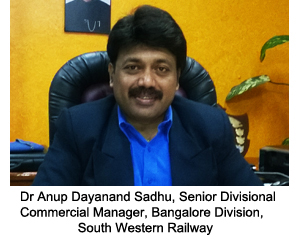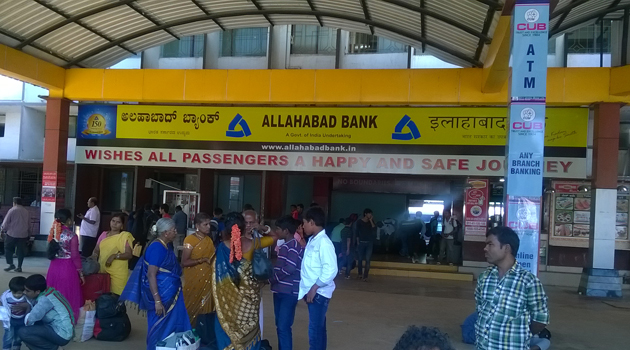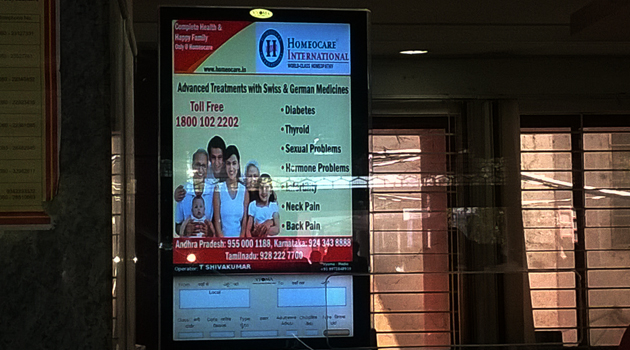Home » Viewpoints » Railways open to new & innovation OOH media: Anup Dayanand Sadhu
Railways open to new & innovation OOH media: Anup Dayanand Sadhu
By M4G Bureau - September 30, 2014
Dr Anup Dayanand Sadhu, Senior Divisional Commercial Manager, Bangalore Division, South Western Railway, talks about the emerging OOH advertising opportunities that Railways offers, in conversation with Rajiv Raghunath of Outdoor Asia. Edited excerpts of the interview:
 With an average 23 million passengers travelling by Indian Railways every day, there is a huge audience for advertisers at Railway stations and other transit points. At a time when the OOH industry is looking to connect with large audiences, the captive audiences at the Railway stations could be a high priority for the industry. Over the years, Indian Railways has created various OOH media opportunities. Do you think the OOH industry has optimally leveraged these opportunities?
With an average 23 million passengers travelling by Indian Railways every day, there is a huge audience for advertisers at Railway stations and other transit points. At a time when the OOH industry is looking to connect with large audiences, the captive audiences at the Railway stations could be a high priority for the industry. Over the years, Indian Railways has created various OOH media opportunities. Do you think the OOH industry has optimally leveraged these opportunities?In the last few years Indian Railways has created a gamut of new advertising opportunities. A lot of flexibility has also been built into our advertising policy. Hence, there is Indoor advertising happening, such as, inside trains. These include both fixed advertising and video advertising. Onboard infotainment has picked up, on the lines of airlines. All these are additional sources of advertising revenue for the Railways.
Under the Bangalore Division we have four trains with onboard infotainment. These are inter-city trains like Shatabdi Express. We are earning significant advertising revenues from the infotainment channel and advertising on fixed media on board the trains, and we plan to introduce this on more trains.
To give you a gist of our Bangalore division, we run 205 mail, express and passenger trains. This is the biggest division in terms of volume of passenger traffic in South Western Railway, and indeed one of the biggest divisions in the country itself, and comparable with Mumbai and Chennai stations. Of course, that does not include the suburban traffic movement in those cities.
Speaking about flexibility of our policy, earlier Railways gave three-year contracts. Now we are open to giving five-year contracts. In July we received a circular stating we can give 10-year contracts wherever capital investments are involved by the media owner.
 What kind of formats will need capital investments?
What kind of formats will need capital investments?They include video walls, unipoles or any major infrastructure development. In such cases, a 10-year contract is highly beneficial to the media owners who invest in them. Moreover, ten-year contracts are attractive to big advertisers. This way we look to enhance our earnings from each division.
To illustrate this, our earnings have increased from Rs 6 crore two years ago to Rs 16-17 crore now. Last year, we earned Rs 16.68 crore.
What factors are contributing to this growth in revenues?
We have not gone in for single station advertising contracts. Instead, we have grouped our stations into three sectors and we called tenders for each of these clusters. This has attracted some of the bigger media owners.
Earlier, for each station smaller advertisers used to quote smaller amounts. The Railway Board's policy now says that an entire division can be given to a single media owner. Two years ago we floated a tender for an entire division but we did not get a good response from the industry. So we decided to look at giving separate contracts for the three clusters.
Did you get enough bidders for tenders to the three clusters?
Yes, we have received good response to the tenders.
What are the branding opportunities on the railway platforms itself? Is there an opportunity to create better quality media in this space?
In the Bangalore division itself we have 87 stations. These include larger stations like Bangalore, Yeshwantpur, Bypannahalli, Krishnarajapuram, etc. All have been grouped into three sectors, and the agency that bags the sole rights to a cluster can develop the best possible media.
While it known that consumption of the media at Railway transit points is of a high order, there isn't enough data on the consumer engagement level. You are in a unique place where that data can actually be captured, gathered and disseminated. Is there an opportunity for you to position the media in the Railway transit points as something that is measurable and therefore attractive to advertisers?
We are open to any advertiser capturing this data or creating such a facility. We have data about the footfalls in particular stations, and we are open to any agency conducting a study on the audience measurement metrics.
 What is the opportunity for creating digital media at the stations? You are located in Bangalore which is the technology hub of the country.
What is the opportunity for creating digital media at the stations? You are located in Bangalore which is the technology hub of the country.There is a plethora of opportunities for the media owners to use digital media at the stations. We want digital media to the come to the stations, especially at the bigger stations. We want the Bangalore station to look like an airport. Unfortunately, advertisers are going in for conventional media at the stations, like glow signboard which do not give an aesthetic value. Perhaps, the reason is that they have to invest much more and be aware of the likely returns.
We have to modernise the amenities at the stations and the advertisers can play a part, especially with regard to information displays, signages, etc. We want to introduce a queue management systems, whereby customers can pick the token and turn up only when their number comes up. That can be a media too.
Now we have fair repeaters. Half the image gives information on destination, fare etc. Rest of the screen can be used for advertising.
Can the outdoor industry play a part in other infrastructure development at the stations, such as, development of public amenities?
Public conveniences or other things require high investments, and so media owners may not be so forthcoming. I do hope that in the coming days bigger investors will come into the picture.
When it comes to train wraps, is your division involved in giving rights?
Train wraps are lucrative to advertisers because they are highly visible. We have called for tenders but the response is not up to the mark. Wrapping of DMU and EMU trains can also be done. We have lots of regulations on the wrapping. We are now open to painting as well. That is becoming popular. I would like to mention here that Srishti Communications has done the wrapping and painting of Chamundi Express.
Just like Srishti Communications introduced battery carts at the stations, do you think there is potential for more CSR engagements at the railway stations?
Srishti Communications pioneered the concept and it has worked very well. We are asking them to cover more stations. Railway Board has also sent a circular to all divisions to replicate the facility.

Stay on top of OOH media trends
Advertisement







